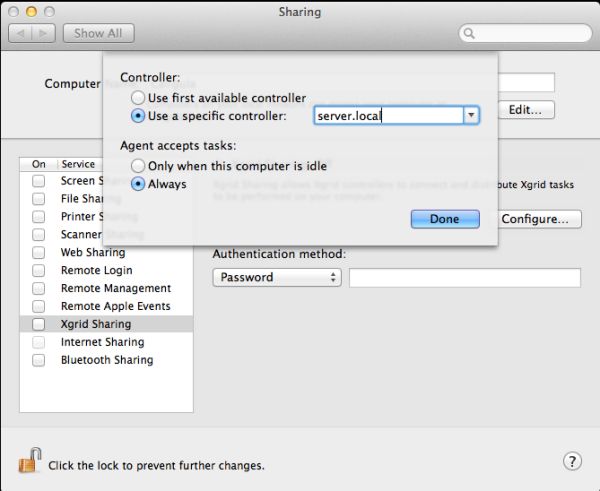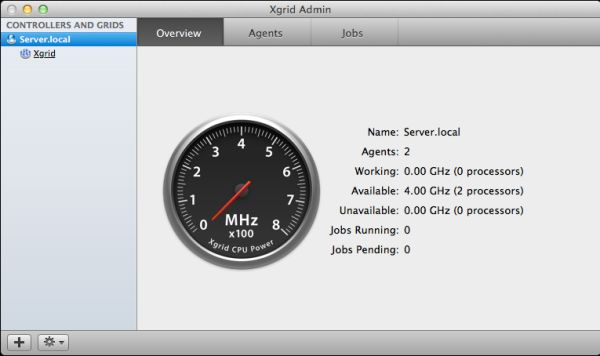In-Depth with Mac OS X Lion Server
by Andrew Cunningham on August 2, 2011 8:00 AM ESTXgrid is the last of the services we'll be looking at tonight, and it's not a new one so we won't spend too much time here. Accessible only via Server Admin, Xgrid is Apple's distributed computing service - basically, it allows many computers to process a single task, thus completing that task exponentially more quickly than any one computer could do alone.
Configuring the service is easy - just select the service in Server Admin, click the Configure Xgrid Service button, elect to create an Xgrid Host, input your Directory Administrator credentials, and you're done.
You can control how clients authenticate to your Xgrid in the Controller tab within the Settings tab. For convenience's sake, I'll just have my clients authenticate with a simple password. By the same token, you can make your server's CPU cycles available to Xgrid in the Agent tab.
Now, to get other computers in on the fun, go to the Sharing System Preference pane, go to Xgrid Sharing, and click Configure. Tell your computer to use a specific controller, and input your server name.
Under Authentication method, make sure what you put here matches the setting you put in on the server, and then check the service's checkbox to start it up.
Now, check to see that everything is working using the Xgrid Admin Server Admin Tool - if you've configured your computers correctly, you should see that a pool of CPUs are available for your use.
Your Xgrid clients can now submit jobs via the command line, and you can use Xgrid Server to start, stop, pause, and dictate the priority of those jobs.
The actual use of Xgrid is a little outside the scope of this review, but sadly it's one of those things that sounds a lot cooler in theory than it is in practice. You can't really use Xgrid to speed up consumer applications from Apple or Adobe - it's best used to help with CPU-intensive calculations, and it's not even ideal for all of those. If you're interested in learning more (and if you're fairly technically literate), I'll point you toward the generally excellent Xgrid wiki and wish you luck.














77 Comments
View All Comments
jedimed - Thursday, August 4, 2011 - link
Does anyone know if Lion Server supports any DLNA media streaming?jay2901 - Saturday, August 6, 2011 - link
sorry if this has been answered already...but if you aren't interested in legacy nt domain controller functionality, can you join a windows 7 pc to lion server's open directory? would love to use this in a mixed (50-50) environment with mac/pcs without needing active directory.ATOmega - Monday, August 8, 2011 - link
Such a limiting selection of hardware and functionality.Running a server, it makes more sense to take advantage of the strong updates and packages in Debian/Ubuntu and just run with that.
I mean, if you're crazy about the Apple hardware, go nuts! But it's clear what Apple really does with server is integrate a handful of half baked UIs with otherwise free software packages. Calling it a "server edition" changes little from an existential perspective.
I'll never understand the appeal of paying up to 3x more to get the same if not less...
tumme_totte - Tuesday, August 9, 2011 - link
Andrew, you say that Windows computers can't join the OD since a Lion OD Master can't be Primary Domain Master for Windows. But in the documentation Apple says something else:https://help.apple.com/advancedserveradmin/mac/10....
Can this be verified? Windows 7 machines can't be joined to Leopard Server (neither Server 2008) and I was hoping Lion would solve this.
Te-Moz - Sunday, August 14, 2011 - link
Andrew, you can set up device management with a self signed SSL certificate.Obviously it's 'nicer' to have one that's authority signed, but for us, we just need Lion server to control our Macs and iPads, push updates and provide some shared storage. (Educational setting)
Great article, and if you wanted to do one on setting up a golden triangle with Lion Server OD and Win AD, then I'm sure a lot of folk would fine that really helpful also. ;)
reese637 - Saturday, December 24, 2011 - link
Hi all. I'm a young tech enthusiast who likes to get his hands dirty in networks and servers and what not. As of now, I've been running our home network with two Time Capsule routers (acting as access points, web servers, backup drives, and file sharing), and many mac desktops and laptops (I believe four MacBooks and two iMacs). For a while now, I've been interested in upgrading to the Server edition of OSX, but I was afraid that it had too many requirements such as xserves, server domains, etc. Now that Lion Server seems to be a bit more consumer friendly and a lot cheaper, I was seriously thinking in upgrading. Would any of you please be able to let me know if there is anything else I need to buy/do in order for OSX Lion Server to actually work in my home? Thank you.Ron Blatto - Thursday, February 2, 2012 - link
I'm new to using any kind of server software and your guide is exactly what I was looking for.